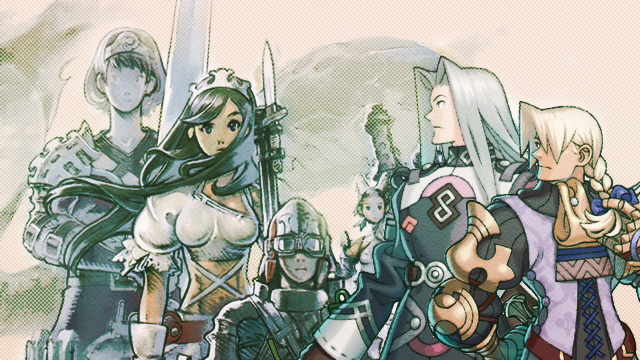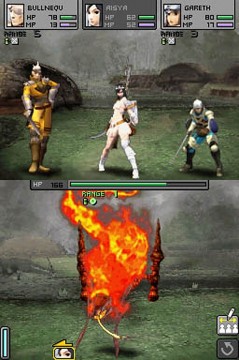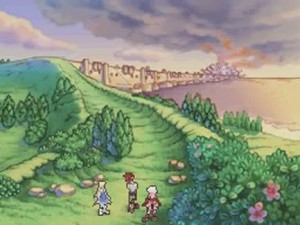
It would be hard to fault someone for thinking Nintendo of America had a personal vendetta against Mistwalker and Monolith Soft. The recent controversy surrounding its refusal to localize The Last Story and Xenoblade Chronicles has been well-publicized, but one need only look a few years back to really put that decision into perspective. Long before either Wii RPG was announced to the public, both developers crafted original works for the Nintendo DS, giving the console some of its finest role-playing games. The titles in question, ASH and Soma Bringer, were among the first unique properties to grace the platform, and all signs seemed to indicate they were destined for a worldwide release. Beyond their initial announcement, however, little else was heard of the games, and they would have likely faded into obscurity had the recent controversy surrounding the developers’ latest efforts not brought their existence back to light. Still, there’s a good chance some of you reading this have never even heard of either title, so we’ll take this time out to give you a little history lesson on the two unlocalized RPGs.
 ASH, an acronym for Archaic Sealed Heat, was by all accounts expected to arrive on North American shores in early 2008. Being Mistwalker’s first handheld venture, the title was also famous for utilizing the only two-gigabit DS game card to date, a necessity to house all of its pre-rendered animated sequences. Set in the kingdom of Millinear, ASH follows the story of Aisya, the crown princess of the land. On the day of her coronation, a mysterious flaming serpent takes to the skies above the kingdom and incinerates everything in its path. Aisya herself is miraculously spared from the firestorm, but her dominion and all of her subjects are razed to the ground in the disaster. Despite this tragic turn of events, not all is lost: her stalwarts are resurrected, phoenix-like, from their own charred remains as ashen soldiers, and they accompany her on a quest to unravel the truth behind the serpent’s attack and restore Millinear to its former glory.
ASH, an acronym for Archaic Sealed Heat, was by all accounts expected to arrive on North American shores in early 2008. Being Mistwalker’s first handheld venture, the title was also famous for utilizing the only two-gigabit DS game card to date, a necessity to house all of its pre-rendered animated sequences. Set in the kingdom of Millinear, ASH follows the story of Aisya, the crown princess of the land. On the day of her coronation, a mysterious flaming serpent takes to the skies above the kingdom and incinerates everything in its path. Aisya herself is miraculously spared from the firestorm, but her dominion and all of her subjects are razed to the ground in the disaster. Despite this tragic turn of events, not all is lost: her stalwarts are resurrected, phoenix-like, from their own charred remains as ashen soldiers, and they accompany her on a quest to unravel the truth behind the serpent’s attack and restore Millinear to its former glory.
Being a tactical RPG in the vein of Fire Emblem, ASH shares quite a few commonalities with Nintendo’s strategy series beyond just its fiery name. As in Fire Emblem: Shadow Dragon (which was actually released after ASH), control is relegated primarily to the bottom screen, while the top one displays character statistics and battle animations. Units come in a variety of different classes, each with its own unique skills and attributes, and they are arranged on the battlefield via the stylus. While this may all seem standard fare for a tactical RPG, where the title really comes into its own is in its combat. Players command only three soldiers per any given mission, and while they are positioned about the map individually, they all come together as a group and draw from the same energy meter when a battle ensues. Aisya herself also has the special ability to absorb the powers of her ashen warriors, although doing this causes the soldiers in question to disintegrate permanently. This last mechanic in particular seems almost like a witting rejection of Fire Emblem’s standards, a conscious attempt to subvert one of that series’ defining characteristics. Rather than worry about the welfare of each unit, players are actively encouraged to sacrifice them, adding another layer of strategy to the game (and forcibly breaking any habits that may have developed from playing Nintendo’s series). These idiosyncrasies combine to make the title a unique experience within its genre and help differentiate it amongst its many peers on the platform.
On the other end of the role-playing spectrum is Monolith’s Soma Bringer, an action-RPG reminiscent of Secret of Mana. Like the Super NES classic, players control a party of three characters, plumbing the depths of dungeons for treasure and battling monstrous foes all in real-time. These characters can be customized to a staggering degree, and the appeal of the title lies in just how flexible this system really is– not only can you select from a list of six different classes (which include standard archetypes like Battlers and Gunners to more unique professions like Kampfs and Darks), but you can also assign a weapon proficiency and fine-tune your avatar’s individual statistics before embarking on your adventure. Gaining levels during play nets you Ability Points and Character Points, which can then be used to tweak your hero even further by allocating them to your weapon skills and base stats, respectively. All of these elements coalesce into what is arguably the most customizable portable RPG this side of Dragon Quest IX, and its emphasis on action and multiplayer would have made it an excellent addition to any dungeon crawler fan’s library.

Where ASH chronicled the well-worn plight of a kingdom in peril, Soma Bringer weaves a more intricate tale of global strife. Set in the world of Barnea, a mystical place where the eponymous Soma, or magical energy, fuels the day-to-day lives of its inhabitants, the game tells of the arrival of the “Visitors,” strange monsters whose very presence inhibits the natural order of the land. Players assume the role of one of seven possible heroes (the rest of which accompany you on your quest) and are recruited into Pharzuph Division 7, a militant force established to stop these alien creatures from disrupting Soma’s flow. With companions in tow, players must venture into the heart of Barnea and stem the invasive tide before it chokes the world of all its lifegiving energy. Of course, in typical RPG fashion, the journey is never quite as simple as it may initially appear, and before long your quest becomes entwined with troubles on a grander scale.
Both titles are certainly intriguing for their own reasons, especially to fans of their respective sub-genres, making their ultimate fate all the more disappointing. It is unknown just why Nintendo had passed on the opportunity to bring these games over to other parts of the world, especially when it had gone through the trouble of localizing even more obscure efforts like Magical Starsign and Glory of Heracles, but it is likely in some part due to the muted reception they received in their homeland. Still, both games were met with critical acclaim upon their release, and while that praise may not have translated into quite the same fervor in sales numbers, the two would no doubt have fallen into a comfortable niche had they been elsewhere. As it stands, the titles are but minor footnotes in the company’s long history book, doomed to be lost amid the grand sweep of time and technological progress were it not for the efforts of Operation Rainfall. Those curious enough can still play through the adventures in their native language, but that does little to temper the sting of knowing gamers the world over were deprived of experiencing two of the finest RPGs in DS’s library.




 ShareThis
ShareThis







This really bad feeling of RPGs continually being passed over during the Wii U generation needs to go away. Nintendo hasn’t impressed me at all with the Wii, and they’ve let other great games pass us by one too many times.
It’s especially funny when considering ASH came out only three years after the original DS, which was long enough for DS to already have proven itself. Considering it was developed by Mistwalker, whose Blue Dragon (of all things) had been released for 360 (of all consoles), it’s kind of a fascinating exercise to wonder why nobody deigned to take a chance on the game.